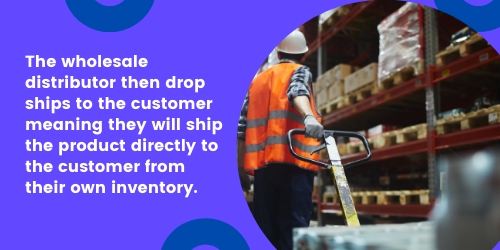Brick and click, e-Tailing, S-commerce…retail jargon is everywhere and just when you think you’ve mastered it all, a whole new group of head-scratching terms seems to pop up. As much as you may want to dismiss new lingo and focus on more important parts of your business, here’s why you should pay attention to them. A lot of insight and value is found in new jargon since they are a reflection of the changes and advancements of an ever-changing market. Take 'endless aisle' for example. Also called extended aisle, it is term common in the retail space along with B2B wholesale distribution businesses as well, especially as businesses continue to develop omnichannel strategies. So, what does "endless aisle" mean?
What is an Endless Aisle Strategy?
An endless aisle strategy allows customers to purchase products that are not physical present in the store or a part of the store’s stock of inventory. Think about the Furniture and Appliance Industry. It’s unlikely that the store will have multiple of the same couch or bed in the back waiting to be purchase.
The idea is that the order is placed with one store and then fulfilled using inventory from one of that store's suppliers. This process is only possible through direct integration with external suppliers and using technology such as ERP software. As far as the end customer is concerned, they are purchasing product from the original store.
The purpose of the Endless Aisle strategy is to create a seamless experience for the customer. It allows the customer to “get what they want” without leaving the store or website.
Endless Aisle Example:
A customer orders product either in-store or online for a pair of shoes from Store ABC. This customer then either pays online or in-store and the product is shipped directly to them.
Behind the scenes, Store ABC lists shoes on its website and in catalogs and other advertising mediums, however, when it comes to inventory management and fulfilling orders, this is done by the actual shoe distributor. They don’t keep all the shoes available to be ready at a moments notice.
Instead, Store ABC’s inventory and accounting software is updated when a new order comes in and sends a signal to the shoe distributors software that an order has been placed and should be picked, packed and shipped. The shoe distributor simply packs the product and sends it directly to the customer.
Integration
When a shoe distributor receives a shipment of new shoes, Store ABC’s software is automatically updated with the new product.
Store ABC might have a computer/kiosk set up in-store that allows its customers to order directly from the supplier, but the products the customer sees are still branded as ABC.
Store ABC simply pays that supplier's invoice for the agreed upon cost for those items and receives a profit in the amount of whatever margin was set for those items and based on the price the customer pays.
The automation of Sales Orders means that the shoe distributor never needs to speak with the customer and Store ABC has the power to determine their profit without dealing with inventory issues.
This method of inventory management and fulfillment is actually very popular. Larger businesses such as Walmart will list items/SKUs on their website and advertise in-store, even if those products are not physically present at their stores or warehouses. When a customer orders an item that Walmart doesn’t physically house, the order automatically gets sent to the supplier/wholesale distributor. The wholesale distributor then drop ships to the customer meaning they will ship the product directly to the customer from their own inventory. The best part of this process is that the wholesale distributor is completely invisible to the customer so it appears that the business has an endless supply of products.
4 Benefits of an Endless Aisle Strategy
Out-of-stock items (OOS) combined with overstocks and even returns cost businesses $1.8 trillion this year. In fact, around 21% to 43% of shoppers will actually go to another store to buy the out-of-stock items so it's no wonder that retailers are jumping on the endless aisle strategy. Some of the other benefits include:
- Supports the Omnichannel Purchasing Experience
- Having all products available on all channels whether it’s in-store, phone, email order or on your eCommerce store will avoid any disruptions to the flow of your customers' omnichannel buying journey
- Eliminate Wait Times
- Rather than having the 'endless aisle' items that are not in the store's location shipped to the store or put on backorder where the customer would have to wait for the product to arrive, the store can easily drop ship the items directly to the customer meaning customers won’t have to return to the store for pick-up and will not have to wait.
- Avoid Overstocking
- The endless aisle strategy prevents businesses from having too much stock which equals extra expense for businesses as it can lead to an excess in storage costs. Having too little stock equals lost income in the form of lost sales, while also damaging the customer's confidence in your ability to supply the products you advertise. Extended aisles addresses both of these issues.
- Increased Sales and New Customers
- Extended aisles allows you to have the freedom to offer a more diverse product catalog and you can leverage cross-selling tactics to offer recommended product.
Whether you're the retailer/store placing orders with the supplier, or the supplier fulfilling these endless aisle orders/drop shipping, it's crucial to implement the correct ERP software in place to automate processes.
As a Retailer/eCommerce Store
It may seem that as a retailer in this situation you would not need a full wholesale software solution since you hold very little physical inventory. However, because you are dealing with multiple vendors, meaning your customer can order product from several vendors depending on the SKU, it is very important to keep track of what product is available, and what orders have been placed.
It's best to find an ERP solution that will allow you to integrate with whatever software your wholesale distribution partners are using. ERP software allows for features such as Electronic Data Interchange (EDI), which enables retailers and suppliers (if they have EDI also) to seamlessly, accurately and instantly exchange information such as purchase orders, invoices, advanced shipping information and more. It can even be used to transmit financial information and payment in electronic form (EFT).
When you submit an order to your wholesale supplier through EDI, they will not need to key in the customers information manually – this will be done automatically reducing any errors on their side.
An ERP solution will also allow you to see what inventory is available for customers to purchase (even if it is an endless aisle strategy), and monitor the shipping of product to the customer that actually placed the order. With drop shipping, the wholesale distributor/supplier will do the actual shipping of the product to the end consumer, but it is your responsibility to send out order confirmations and shipment tracking information to your customers which can also be automated through the software.
As a Supplier
ERP software and EDI is a benefit for both the retailer and the supplier - as a supplier, you will automatically receive all the necessary information to fulfill the drop ship order for your customer's customer.
- Shipping: The retailer takes customer orders and shipment information, and transfers these via EDI. The ERP software is able to generate shipping labels with your customers logo/information on it and indicates the shipping information for that drop ship order. This is commonly found in the eCommerce arena, and specifically with Amazon. Although Amazon holds a lot of their own inventory they also generate drop shipping of product by other distributors and wholesalers.
- Automating Picking and Packing: The ERP system generates a pick slip so that warehouse staff can begin picking items. Functionality such as verification barcode scanning at the packing station or mobile barcode scanning during the pick process ensures that there are no human errors. Once the item is packed, the system will generate and print any required paperwork and share information electronically between shipping carriers in order to generate a tracking number and cost information.
- Invoicing and Inventory Updates: Once the order is shipped and is dictated as such in the system, you can automatically post the invoice and email the invoice directly to your customer. The inventory count will also be updated to show your customers the latest product count available for the items you shipped.
- Reorder Management: Reorder management is another big benefit with wholesale software and will help you to have the right amount of stock in place to fulfill your customers' endless aisle orders. This functionality automatically assesses which SKUs or product you need to order and generates purchase orders for these items. A proper solution such as Blue Link’s wholesale software utilizes robust reporting capabilities to pull historical sales data based on product within a given timeframe. You can easily pull sales information from within Blue Link to view data for the number of units presently on hand for individual or multiple items, units on backorder, units on purchase order and average monthly units sold to better prepare for these endless aisle sales. You also have the ability to flag abnormal sales so it doesn’t impact the monthly average projection.
As you can see, there are many benefits to implementing "endless aisles" within your organization if you have the resources to do so. The most important factor is to make sure you have the processes and systems in place to support a seamless endless aisle workflow, or else you won't be able to gain any of the benefits.











